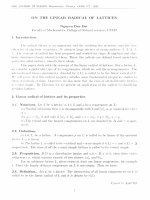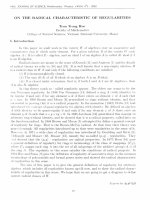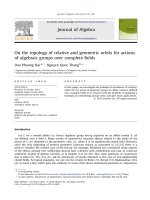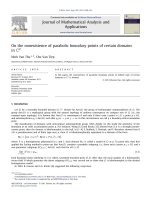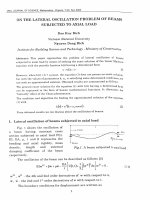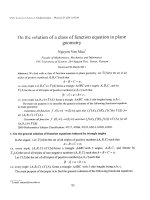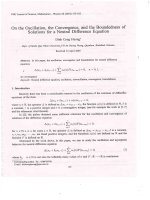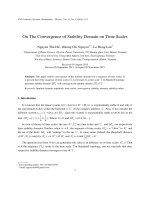DSpace at VNU: On the linear radical of lattices
Bạn đang xem bản rút gọn của tài liệu. Xem và tải ngay bản đầy đủ của tài liệu tại đây (1.7 MB, 5 trang )
VNU JOURNAL OF SCIENCE. Mathematics - Physics t.XVIII n°l - 2002
ON TH E LIN EA R RADICAL OF LATTICES
N guyen D ue D at
F n cu liy oí' M ỉìLlicm nìics, College o f N n tui’fil sricnces. V N Ư IỈ
1. I n t r o d u c t io n
T lir radical theory is an im portant tool for stud ying th e structure and th e cliissiliration of algebraic structures. It attra cts large interest of many authors 1. 2. iỉ. r>.
7 rii<‘ concept o f radical has been proposed and studied for rings. /\-a lg e b r a s and
bi;ii< structures C'lost'ly related to them . There, the radicals are defined bas(‘(l upon their
particular suhstrurturos. nam ely their kh'als.
This paper (Irais with the' concept o f the linear radical o f lattices. For a lattice L.
\vr Consider H particular typo of its eongnum cies, which wo call linear cuutfnim rirs. T h e
ilit <‘1st 'it ion of those congruow ios. denoted by r ( L ) . is failed to !)(' tli(‘ linear radical of L.
\ \ r will prow I hat this radical property satisfies sonic* fundam ental proportion similar to
1 1|
NI<»
2 .1 . N o t a t i o n s . Let L be a lattice. a, I) € L and fj bo a congruence on L :
(a) Sym bol alb means th at (I is incom parable with I) and [n]/t is /> equivalence cii\y*
ol a.
(I)) {
[b]p and 9 .1* 6 ỊíiỊ,,. 3 (J 6 [/>],,../• < y.
(<•) T he trivial and the largest congruencies OM L are denoted by A and r. lesp ect ÌV (‘ỈV.
2 .2 . D e fin it io n .
n) l.('t L he rt Initier.
lu i 1i
A congnum ce Ị) ou L is calk'd to 1)0 I incu r if the (Ịĩìoticììt
I>) The Intticc L is ('Ỉiỉl('(l to be r-rn d icn l and r-sem i sim ple i f r ( L ) = /• Ĩ 11 KÌ v ( L ) = A
vespertiwly. T h e class of nil the I'-sciiii sim ple lattices is called to 1)1' r-s e iili simple.
2 .3 . P r o p o s it io n . I f D is ĨÌ d is trib u tiv e lattice and a,ft € D sd Ỷ b. then th e n * e xist<
congnumcc f>. which consists exactly o f two classes: [a]ft and [b]f}.
For nil a rb itra ry lattice L, there exists at heist one linear congruence, for exam ple
I Thus, th(' fam ily o f linear congruence on L is non-empty. Then we have:
2 .4 . D e f in it io n .. Let L be ci lattice. T h e intersection u f till linear congTiH'Jicics ou L is
a llie d to be th e linear radical o f L HÌUÌ it is d e n o te b y r ( L) .
T y p ese t l»y
1
N guyen D uc D at
•)
2 .5 . E x a m p le s . C onsider latt ices M;\ and Nr,:
1) For M'\. there exists linear congruence r only. Therefore r(A/;0 = T.
2) For Nr >. besides T. there exist 2 linear congruencies, Nam ely, Pi consists o f the
classes {a. h. 1 \ %{(). r} and p 2 consists o f the classes {0, a, />}, {c, 1}. T hus 7 ( iV.5 ) = /?! n />'2 .
which consists of classes = { a . 6}. {(;}, {0 }, {1 }.
2.6. Proposition.
( Ì ) For ỈÌÌÌ Hi bitrnrv Ini tier L %the quotient lattice L / r ( L ) is distributive.
(2) L('t D h r ri latticc. Then D is (listrihut i w if find only ifÉr ( D ) — A .
Proof. (I ) We have r ( L ) = n {/),ị/ f I } . where /),./ 6 / . are linear congruencies on
/.As well-known. L / r ị L ) i.s tlu* Mil>-
tin* other hand, by definition, L /f), is distributive for each i € I. T hus, the quotient lattice
L ' r ( L ) is distributive too.
(2) It follows directly from (2.3) and the part (1). □
2 .7 . R e m a r k , ( h ) Let psơ he congruencies Oil L such that p Ç Ơ.
T h e sym bol f)/o
iỉcụụtvs ri congvnviice on L / p as follows:
( M ,»[
{ s . y ) € Ơ.
(b )
Let f : L —> V he a lattice hom om orphism and Ơ be a congruence OI) L . T h ru
U1Ỉ ç [ L ) thf'iv exists a congnw iKV ip(ơ) :
(
ip(ơ) <=> ( x , y )
€
Ơ.
Setting f) = /\e r ^ we have V?(L) = L Ị p and (ơ V p ) /p are a congruencies Oil L / p .
It Crin he easily (k'duci'd that (
(í3*]/9’ [y]p) £ (ơ v
2 .8 .P r o p o s it io n .. Let L , Ư be lattices rind
Ư be a hom om orphism , then
ç ( r { L ) ) Ç r (^ (L )).
Proof. Put () - K e iy . A ccording to (2.7 )(b ). instead o f
According to the definition o f radical, r ( L / p ) is equal to the intersection o f the
linear congruence on L / f). By (2.7)(a) these congruencies are presented as ơ//). where (7
is a congruence on L such th at p Ç Ơ ç T.
F irst. we prove: (j//9 is linear on L j p if and only if Ơ is linear oïl L.
Necessity . Let ơ /p be linear and X ,ỉ/ E L , ( x , y ) ị <7. It is needed to prove that
k U < \y\fT or [ỉ/Ịrr <
According to (2.7)(a):
ỊyỊff) ị ơ Ị ọ and so we shall show:
A " < \y]rr- Since ơ / p is linear, w ithout loss of generality, we can assum e th a t [x]p < [y]p.
O n the linear radical o f lattices
B y (2 .1 )(b ). thcro C'xist ./•'
and y* € [y]ft such that ./•' <
Since Ị) Ç a. it implirh
./•' G [ . / > , / / e iyj,T. i.e.. 1-J-j.T < WinS nffirinrcy. T ile proof is trivial.
Now. considering all th e linear congruence ơ jf> . i £ / , on L//>, wo liavc r { L €‘rỊĩ) —
\ n , (> i
/} \ n , ! Ç / } / p . M ay be {ơ ,l/ € Í} (iocs not contain all the linear
con&riioncv oil L. TluTofon1 r ( L ) c n{ỡr,ị/ G / } . T hus. (r (£ ) V /?)/p Ç n{cr,|j G I \ Ị ị >. i..
e.. x p (r(L )) ç r ( ç ( L ) ) .
T he proof is complet I'd. n
Sitnmivruf up. vvc Imve proposed th e concept of linear radical r ( L ) oi’a lattie*' L and
sliowrd the important properties o f r [ L ) (see P ropositions ‘2 .6 and 2.8):
1) If
V is a hom om orphism then ý ){r (L )) Ç r(
h isw o rtli nient lolling that thrsr properties are formulai (‘(I anal()"Ou.>h tu those of
radicals o f rings.
3. Application
111 th is section wo present an application o f the linear radical to classifying modular
lattices. Here, for lattices, it is particular that p is r-sem i sim ple class. Therefore, the
classification problem is o f interest itself.
For exam ple, consider a m odular lattice A /. A s in E xam ple 2.5. we see that M ạ
is r-iadieal lattice.
On the other hand, the sublattices of M which are isomorphic to
A/.J prevent M from being d istribu tive. Since M / r ( M ) is distributive., each sublattice
isomorphic to M\\ belongs to on e of equivalence classes of r ( M ) .
Based upon t.ỈK' above reasons we arrive at th e stu d y of the particular modular
bit tiers form ulated in the following th eorem .
3 .1 .
T h e o r e m . Lot M !)(' a m o d u la r lã t t k r which is not distributive.
Let .4 ÌH' ỈÌ
sublattice o f M such tlmt:
1) A is convex.
2) A is r-nulicnl.
3) A contains all sublattices o f M which are isom orphic to A/3 .
Then r ( M ) has one class equal to A, the other classes ( i f they exist) are distributive.
Proof. We can assum e that M
A and use th e following lemma.
3 .2 .L e m m a . I f b G M A then in M there exists a two-classes congruence, OJIO class o f
which contains A , the other contains b.
Proof For I) and A. we have the following alternatives:
(I) 3a € A. (I < b.
(II) E ither Va € A .a\\b or 3a € A . a > b.
For case (I), consider the principal filter generated by I) : F(b) = {./• € M \.i > b).
If 3c € F ( b ) n A then (I < I) < (\ it im plies th at b € A (due to convexity o f .4). but it
contradicts the assum ption. T hus F { b ) n A = 0.
We den ote by T the' ffiinily of all filters containing b lmt not any element of A.
Consider T w ith relation c . Let { / \ | i € / } be a chain on T . it is easy to deduce* that
N guyen D uc D at
\ F , / i 6 /} € T . Due to Zorn's Lemma, there exists a maximal rlriiu nt of T which we
denote 1)V F .
Wo consider the ideal generated by A again ./(^4) = {;/• 6 M/.V
(I for som e a 6 *4}.
Obviously. 7 ( i ) ) n F = à.
For case (II), we take th e principal ideal generated by b : J(.-l)
{./.* G M \ x < b}.
Obviously, J ( b ) n A =
Sim ilarly to case (I) we can deduce that there exist the maximal ideal ./ and the
maxim al filter F such th at I) € »/,.7 0 / 1 = 0 and .4 ç F, .7 f F =■ </>.
Now. for both cases (I) and (II) we shall prove that ./ u F —.Ì/
w v suppose that 3c* € A /, c Ệ J u F . First we prove the assertion:
(i) \ j £ J J V c £ F .
hulivd. if V / € rm isists of elem ents as c . j . j V c w ith j € ,/. D enote J ( h ' ) = {*r 1-r ,\/;.r < A- for som e
/.* /\*ị. it im plies th at ./ Ç J ( K ) and J (A ’) n F = 0 . T his contradict> the m axim ally of
Thus (i) is proved.
B y duality wo have th e sim ilar assertion:
(ii) 3 / € F, / A r € J
In tilt' rest, wr consider 3 elem ents j , / . c. We have:
j
A / • j A r.
j
V /. j V c J V c e f
f
A
r
e
J
and
7/ = ( j A / ) V ( j A r) V ( / A (•) ' ./.
and u = ( j V / ) A ( j V r) A ( / V r)
F.
It im plies th a t u < I? and since ./ n F = 0 , ?/ < V.
Put
J \ y . z <\s
follows:
X — ( j A v ) V u = (j V It) A r.
// — ( / A u) V u = ( / V u) A t\
2 = (c A />) V //. — (c V Vi) A />.
(1)
(2)
hold.
Sum m ing up, we have:
a* A y = [(j A t>) V I/] A ị ( / V u) A v]
= { i(j A ií) V u] A u} A ( / V u)
= {[O' A
v )
A
v \
V Í/} A ( / V •».)
(u < v)
= [O' A v ) V u] A ( / V u)
= [(/ A ?/) A ( / V u)] V u
= {[j A ( / V r ) | A [ / V ( j A r )|} V «
( a
< / V
(s o e (l).{ 2 ))
= { ( / V c) A [j A ! / V (j A c)]]} V V
= ( /V r ) A [(jA r )V (jV /)]V u
= [Ơ A c) v (j V / ) ] V a = u
It)
(./'Ac <
j )
O n the linear radical o f lattices
B y d u a l i t y \v<‘ a ls o o b t a in .V V // = 1\
Iln v . elem ents
.r V : - ;/ V : =
c play the sim ilar role.
Therefore. ./• A z = y A c = Í/ and
r.
Tim s, ill .1/ t here exists su b latticc H = {.r.//. c . //. r }. Since I I ii> isom orphic to
it iln p lio that <‘iihrr H
J or / /
F according to the i(l(*ntification o f ./ and f \
th is (Oiitradicls I hr fact that // * ./ and r G F .
ill final. wo sre that ./
/• = A /.
But
T his m oans that .1 and F form a tw o-class
(*quivaloncc\ w lin v <*ilh(T A
f: F in oa.se (I) or I) € ./.-4 < /* in case (II). Because J
is an ideal and F is a filter, il follows th at this equivalence is a congruence. T he Lemma
is proved.
Now \w finish (h< prool of T heorem 3.1. Since A is <\ 1-radical lattice, every linear
nm ^ m cn cr on L lias a clfKss containing A. By virtue o f Lem m a (3.2) th e equivalence' class
o f r ( M ) containing /1 is 0XHCt.lv equal to .4. T he other classes are su b la ttice o f M . T hese
subiaftice* contain !)() sublnttice isom orphic to A/ 3 , therefore, th ey arc distributive.
T he proof o f theorem is com pleted. □
3 . 3 .R e m a r k . It is worth re m a rk in g that lattices, ill general, are not d istrib u tive l)OCciu>v
thi'Y may contain not only the su bla tticc M; ị . hut also Xr>- Therefore, the classification
ỊỉVoliìrm is difficult (sre E x a m p le 2.5).
References
1. S.A. Am itsur. A general theory o f radicals II. R adicals ill lin g s and bicategories,
2.
3.
4.
5.
G.
7.
A iiirr. J. Math., 7 6 (1 9 5 4 ). 100- 125.
T. Anderson. N. Divinsky. A. Sulinski. H ereditary radicals in assoc iative and alter
native rings. Catiad. ./. Math.. 1 7 (1 9 6 5 ). 594 - 603.
V .A . A nclrunakevitdi. O n the Theory o f the lin e a r radicals. D A N U SSR . 1 1 3 (1 9 5 7 ).4 8 7 490.
G. Gratzcr. General lattice theory. A kadem ie -Verlag. B erlin, 1978.
A.G. Kurosh. Linear R adicals and Algebra* Math. Collection. 3 3 (7 5 )( 1953). 13-26.
A. G. Kurosh. Lectures on general Algebra. P h ys - M ath., P u b lish in g house. 1974.
F.A . Szsz. Radicals o f lin g s. Akadm iai Kiacl. B u d a p est, 1981.
TAP CHI KHOA HỌC DHQGHN. Toán - Lý. t.XVIII. n °l - 2002
VỀ CÁN TUYẾN TÍNH CỦA CÁC DÀN
Nguyền Đức Đạt
K h o a lo a n . D ụ i h ọ c K h o a học T ự nhiên - f ) I I Q ( i / l ủ N ộ i
Bài háo này tie cập tới khái niệm cúa các dàn. Căn tuyến tính của dàn L được
hiểulà giao của họ lát cà các tương đẳng tuyến tính trên nó và được ký hiệu là r(L).
Căn
tuyến tính cua dàn thoả Iĩìăn các tính chất cơ bản như cá c càn của vành và nhận lớp
c á c d à n p h a a n p h ố i là m lớ p / -n ử a đ ơ n . Đ ị n h lý 3.1 c h o á p d ụ n g h ữ u íc h c ú a c ả n tu y ế n
tính trong việc phân loại các dàn Modular
